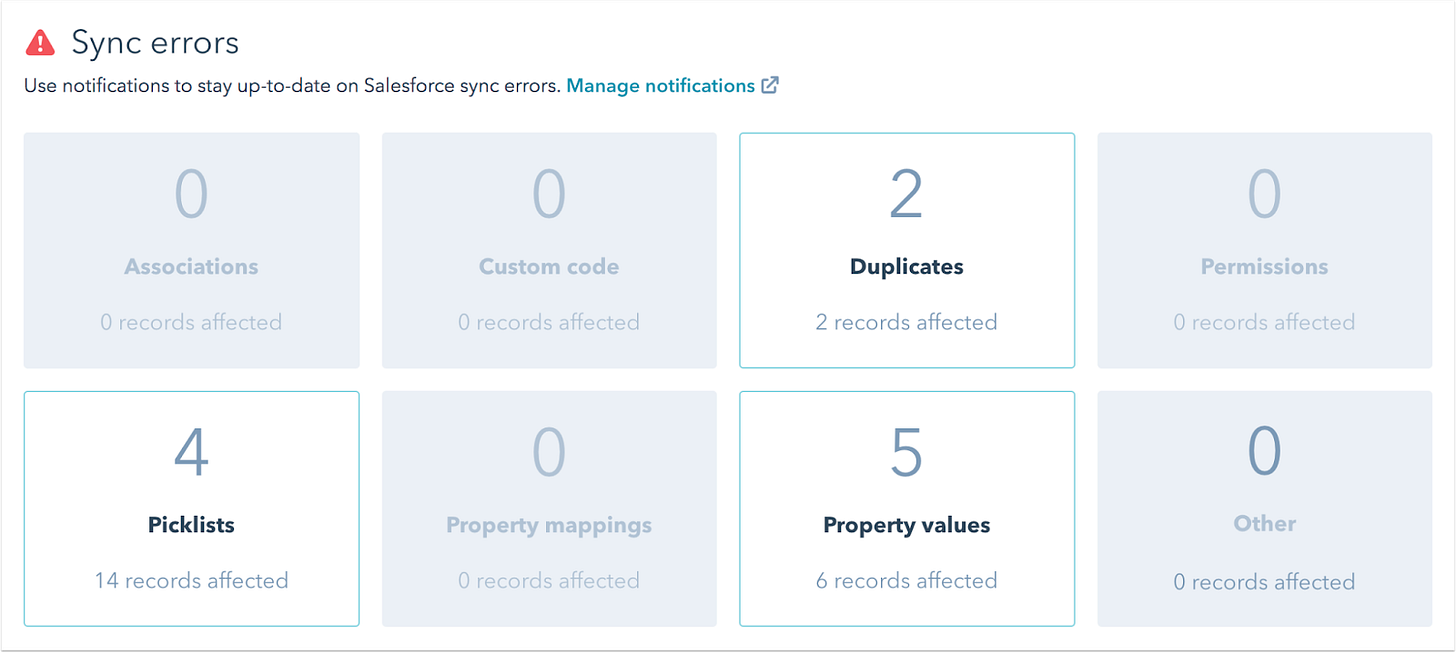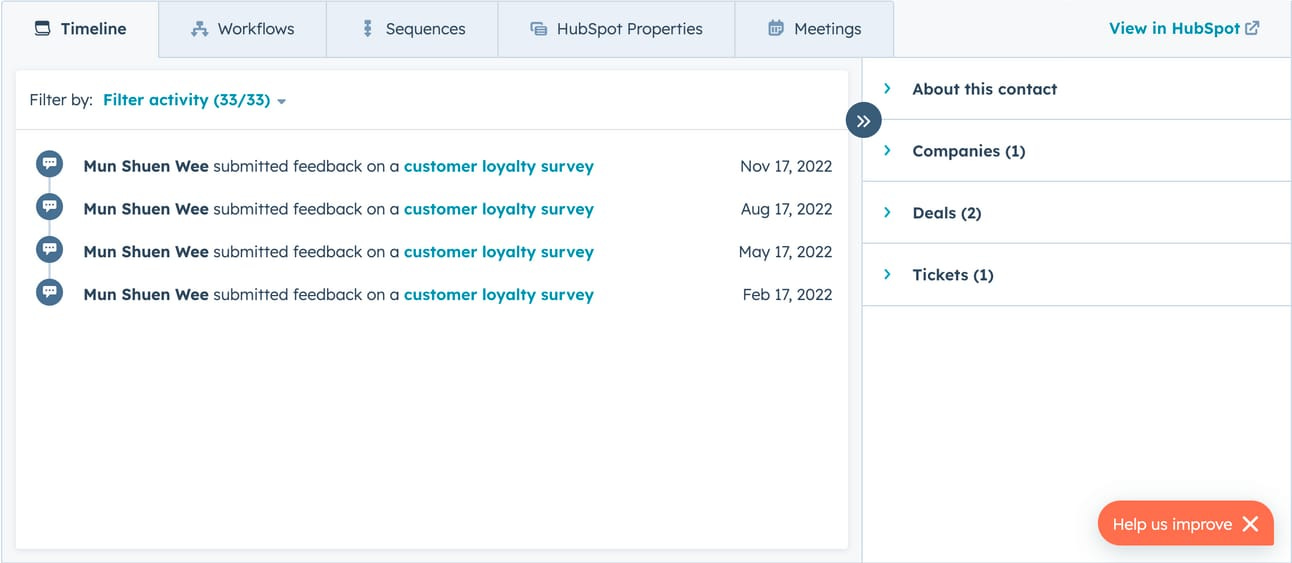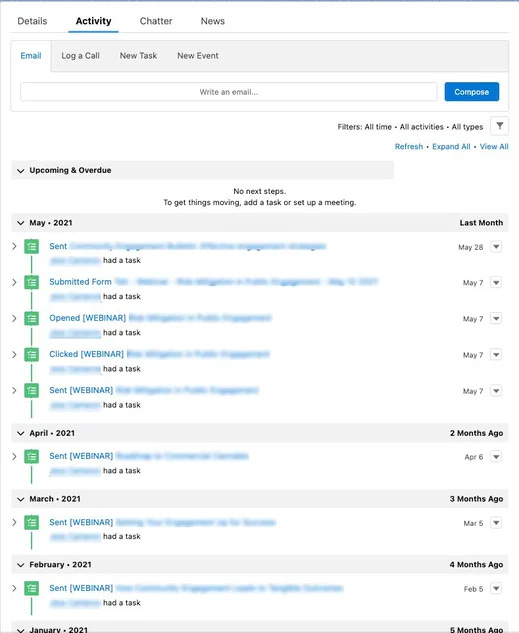HubSpot and Salesforce Integration Series (3/3)
Sync (Errors), Use Case, and Best Practices
In part one of this guide we talked about the general setup for the HubSpot and Salesforce integration and in part two we discussed the necessary steps to perform the integration. Now, your integration should be live and we can look at the sync (errors), use cases and best practices.
Table of Contents
The Sync
Monitoring the sync is important that your integration is working properly.
Sync frequency
The sync frequency between HubSpot and Salesforce is happening every 10-15 minutes according to HubSpot. However, many users and we also witnessed synch frequencies in the 5-10 minute range. Good guy HubSpot is playing it safe by underpromising but overdelivering.
Sync Errors
Errors will eventually happen in every setup. The good thing is HubSpot lets you manage those in the sync errors section.
There are 8 types of error as you can see from the screenshot below.

We covered previously the issue with duplicates and picklists. Picklists relate to bad admin and duplicates have to be continuously monitored. Other common issues are with:
Property values - the field values do not match in both platform
Custom Code - a flow, validation rule, or similar breaks the sync
Less common are:
Association error - the record and objects do not match
Property mapping - mapping fields that are not the same (e.g. mapping a check box to a number field)
Permissions - the connected user has not enough right
Other - usually you will need HubSpot support to figure those out
A detailed overview from HubSpot on how to solve each can be found here.
Sync Error Notification
You can set up synch error notifications in HubSpot. This is helpful as it helps you resolve the error.
Our recommendation is to use daily sync error notifications to not delay business operations.
Other options include instantly and weekly.
Deletion policy
You can set up what is going to happen in each platform when a record gets deleted. The options are: do nothing or delete the record.
We recommend setting the deletion policy to “Delete the record”.
Usually, only a limited number of people are allowed to delete records, and often a deletion is regulated by privacy laws like GDPR. Meaning, it is easier to have a centralized system and to trigger the deletion from there to all other platforms through integrations.
The alternative would require to execute a deletion in multiple systems. That is time-consuming and has the risk of missing a record, which in turn would result in non-compliance with the regulation.
The best practice would be to have the CRM as the central point and if a deletion is triggered there for a record it should remove it from all connected systems. Be that HubSpot or any other platform.

HubSpot Campaigns and Salesforce Campaigns
The campaign object is important in Salesforce and HubSpot, but they are significantly different. Therefore, there is no real sync between the two.
HubSpot Campaigns report on marketing assets. Salesforce Campaigns report on Campaign Members (Leads and Contacts) and how they impact Opportunities (Marketing Attribution). The Campaign Object is very powerful in Salesforce and the core building block of Account Engagement - the Salesforce competitor to HubSpots Marketing Hub.
Most businesses are using both Campaign features and we can also highly recommend using both.
As those two objects have different tasks there is no sync but you can connect them. Once the integration is complete, you have the option to create a workflow in HubSpot. That workflow would enroll HubSpot Campaign members in existing Salesforce campaigns. HubSpot can not create a new campaign, so it is required to create the Salesforce campaign before setting up the HubSpot workflow.
This will allow that the campaign history is visible in Salesforce and attribution will be possible to calculate. Although not as smoothly as if one would use Account Engagement.
Finally, it is also possible to sync Lead / Contact campaign member status back to HubSpot so it is possible to see in which Salesforce Campaigns a HubSpot contact is enrolled.
User licenses - who needs one?
Once you roll out the integration, you also need to decide who requires a user license for HubSpot. The question here is not even price but more the question of who needs to do what.
Who needs a license:
Marketing Users
System admins
Who doesn’t need a license:
Sales User
Support User
Managers of other teams than marketing
You use HubSpot Marketing Hub for Marketing Automation. It is not your CRM, therefore only the marketing team and relevant system admins should use Salesforce.
Don’t get funky ideas to use HubSpot as a second CRM.
For example using also the HubSpot Service Hub. Businesses that tried this just went into problems as what they did was build two CRMs. Hardly any business has the resources and nerves to maintain two CRMs. Just be aware your HubSpot account manager will try to sell that to you.
Only the marketing team and system admins need a HubSpot Marketing Hub License.
Integration use cases
There are various use cases for the integration. Most of them are centerer around visibility and connecting workflows.
Visualforce page
The main use case will be to provide visibility to your sales team. This may involve the Visualforce page in Salesforce. It is one way to give your team visibility into the Marketing Activities.
But we don’t recommend implementing the HubSpot Visualforce page.
You will see why soon.

The newer version allows even more functions that compete one-to-one with Salesforce functionalities (see below). In other words, you are maintaining two CRMs.

Don’t use the new HubSpot Visualforce page
You shouldn’t use the new Visualforce page from HubSpot. It will just create conflict. As mentioned above, these features are competing with other products.
Timeline → Activities
Workflows → Set by admins
Sequences → I bet you already have a better sequencing tool
HubSpot Properties → Better set up to map to fields if relevant
Meetings → You for sure have a solution for this
About this contact → Fields on current record page
Companies → Account
Deals → Opportunities
Tickets → Cases
This is building a second CRM. Don’t do that.
It creates only conflict between the team.
Tasks
A more common option is that the HubSpot marketing activities are also synched to the activities feed in Salesforce in the form of tasks. Most sales teams use it like that as they see their direct activities (calls, emails & meetings) next to the marketing activities. This is very actionable.

Campaigns for visibility
We discussed earlier how workflows can enroll people in Salesforce Campaigns.
The best practice would be that for every marketing campaign like Webinars, Ebook downloads, conferences, demo requests, and the like. You would have a salesforce campaign.
The HubSpot integration would then enroll the people as campaign members into campaigns.
This would provide a clear visibility for everyone about the marketing engagement and can make marketing attribution easier.
Workflows: Example webinar follow-up
We once built an integration between Zoom Webinars, HubSpot Marketing Hub to Salesforce. It did the following:
Lead capture in Zoom Webinars and marketing opt-in.
Send Lead to HubSpot.
HubSpot workflow to update Salesforce Campaign members.
On the day of the webinar, update attendance status.
Have instantly a follow-up list for the reps
This was very powerful as it saved hours of manual work, gave proper marketing attribution, and the team could do a follow-up with hot leads within minutes.
Best Practices
Here are some last best practices to follow for the use of the two platforms.
Clear Sales Process and Conversion points
HubSpot and Salesforce have competing features as we have just seen. It will lead to a mess if users start using the same capabilities on both platforms. For example, using both platforms for lead management.
That is why it is important to define clear use cases along the sales process for each platform and train the users on them. We recommend turning off features that should not be used to avoid any confusion (like the HubSpot Visualforce page).
Reporting System
Reporting is also possible on both platforms. In cases, when you don’t leverage an external Business Intelligence tool for reporting, we recommend defining clearly where reporting is taking place.
This can be that all marketing-relevant reporting takes place in HubSpot and all sales-related reporting takes place in Salesforce. It is important to have a clear cut to avoid unnecessary copy and pasting of information.
Sandbox
We recommend the use of a sandbox if you have a larger team or sensitive data. The sandbox can help you avoid costly mistakes and many headaches as you will see how your integration is behaving.
A sandbox takes some more effort to manage, hence we don’t recommend it for small teams as those resources are usually better spent on more value-adding activities.
Admin process across integrations
Consider how the integration will impact your admin processes. For example, when you update a picklist value in one platform then you need to make sure to update the picklist platform in the other platform. Another example is when you create a mandatory field then it needs to be also mandatory in the other platform.
In short, your admin processes need to consider if they will impact the integration. And if they impact the integration make the best choice that it does not break the integration.
You are done 🎉
Congratulations! You are done with your integrations. We hope the guide was helpful to you and that you were able to learn something new.
Next week, we are starting with our AI Series and its impact on GTM & RevOps. Stay tuned!
Revenue Wizards is a hands-on Revenue Operations Consultancy for growth companies focusing on efficiencies. We provide GTM & RevOps support with the goal of Revenue growth, GTM cost reduction, and Profitability. You can learn more about Revenue Wizards here.
Zhenya Bankouski is Co-Founder and Revenue Operations Partner. You can follow him on LinkedIn 🔔 where he posts regularly with practical advice on building efficient RevOps teams and truly data-driven organizations.
Haris Odobasic is Co-founder and Revenue Strategy Partner. Enjoys bringing strategy to life with RevOps.

